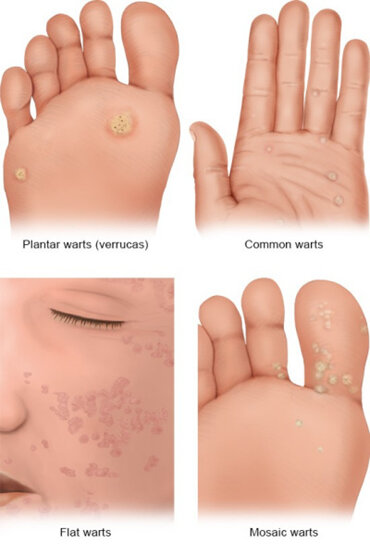Warts are a common benign infection caused by the human papillomavirus (HPV). They can develop on various parts of the body and present in various forms. Warts are very contagious and most people will have one in their lives.
Most warts are harmless and will go away on their own within a few weeks or months. There are a number of different treatments that can make warts go away more quickly – but they don't always work.
Viral warts aren't the same as “senile warts” (seborrheic keratosis), which usually first appear in older age and aren't contagious. Senile warts are also quite harmless, but permanent. This information is about viral warts only.
SYMPTOMS
Most warts do not cause any bothersome symptoms, but may also cause the following:
- Itching
- Tightness or a feeling of pressure
- Warts on the sole of your feet may be painful
- Small black/brownish dots caused by clotted blood that has leaked from the capillaries
Warts may appear alone or in groups, which may then cover larger areas of skin.
PLANTAR WARTS
A planar wart or verruca is found on the feet, mostly on the ankles and soles of the feet (also known as varuccas). They can become quite large. Because the soles of your feet have to support your body weight, plantar warts do not grow outward like other kinds of warts. They are pushed inward when you stand or walk. This can cause pain or tenderness due to the pressure. It also makes it difficult to treat this kind of wart.
They are usually transferred from person to person in places such as changing rooms and showers where minor damage to the surface of the skin can allow the virus to enter the sole of the foot. They cause considerable pain and discomfort when standing or walking.
COMMON WARTS
Common warts may occur anywhere and often develop into clusters over time. Usually common warts are found on fingers, the back of the hands, the skin around the nails, knees and on your feet. They form small raised lumps that can develop into cauliflower-like growths. They harden, making them rough and scaly to the touch.
GENITAL WARTS
Genital warts are spread by sexual contact, they occur around the sexual organs and may also develop into clusters but they do not usually cause any pain. They are small hard nodules with rough surfaces. Patient should seek GP treatment.
RISK FACTORS
-
People who work with raw meat
-
Children and teenagers who often use communal showers
-
People with family members who have warts
-
School children who have many classmates with warts,
-
People who have a weakened immune system
PREVENTION
These precautions may help with spreading the infection to others and to other areas of your own skin:
-
Cover the warts with a waterproof plaster when in public pools, etc
-
Do not share towels, shoes, gloves or socks with others
-
Do not go barefoot at swimming pools, or in communal showers or changing rooms
-
Do not touch the warts
-
Do not scratch or pick at warts, otherwise the viruses might spread.
-
Wash your hands thoroughly anytime you touch the wart
-
Keep your feet dry.
-
Put on clean socks every day.
-
Do not use instruments like pumice stones or nail files if they have previously been used on a wart
Because warts are highly contagious, it’s hard to completely prevent them from spreading. Also, it’s hard to tell how someone got them since it can take months for a wart to develop after the skin becomes infected.
TREATMENT
Warts don't normally need to be treated and are self-limiting and resolve in weeks or months, sometimes even years. Some find them bothersome and want to treat them. The two main options available for treatment are:
-
Salicylic acid solution: This is put on the hardened skin of the wart several times a day over the course of a few weeks to gradually dissolve it. Some of these products also contain lactic acid.
-
Cryotherapy: Cryotherapy involves freezing the wart by applying liquid nitrogen. This is usually done by your GP. The nitrogen is extremely cold, and destroys cells in the skin’s outer layer. The treatment is repeated several times, with a break of at least one week between each session. Liquid nitrogen is very cold so it may cause brief stabbing pain, and the skin may turn red or swell afterwards. Blisters sometimes develop too.
Both of these treatments are generally effective, but don't always get every last wart. Plus, sometimes viruses might remain in the skin after treatment and then lead to the growth of new warts later.







